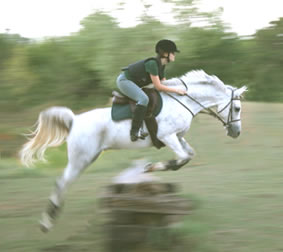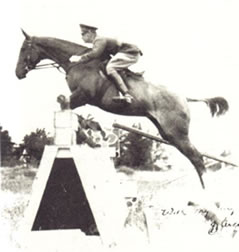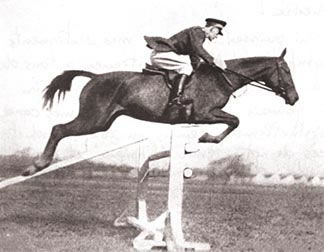 Few American riders actually know what the traditional Balanced Seat or method really is. I’ve been riding it since the 50’s and teaching it for 30+ years, and have found that the majority of contemporary “English” riders are aware of only the Hunter/Jumper Seat the Dressage Seat. Riders who seek out the traditional Balance Seat tend to be eventers, fox hunters, polo players and mounted police officers. Plus, after the Afghan War experience, US Special Forces are receiving an introduction to this traditional military method. Few American riders actually know what the traditional Balanced Seat or method really is. I’ve been riding it since the 50’s and teaching it for 30+ years, and have found that the majority of contemporary “English” riders are aware of only the Hunter/Jumper Seat the Dressage Seat. Riders who seek out the traditional Balance Seat tend to be eventers, fox hunters, polo players and mounted police officers. Plus, after the Afghan War experience, US Special Forces are receiving an introduction to this traditional military method.
There are several primary differences between the Hunter/Jumper Seat and the Balanced or Military Seat. Perhaps the greatest difference is the focus in effectiveness in the traditional Balanced Seat, and a focus on style in the historically much later Hunter/Jumper show seat. These differences are demonstrated in the pictures show here. |
| The two black and white pictures show soldiers balanced securely in their stirrup irons, with their hands on the side of the horse's neck, not leaning or balancing on the neck. In this position the rider has a very low center of balance, and is in a position to follow the horse's neck movement with his hands as the horse balances the rest of the body over the jump, thus maintaining uninterrupted control by contact with the horse via the reins. Note also that the riders tend to stay close to the saddle with their seat which facilitates a quick return to the saddle where they can use their seat to direct the horse quickly after the jump. The young contemporary rider on the white horse is also using this traditional method. |
 |
|
|
|
 The contemporary rider on the brown and white horse is using a different method to release the horse as it goes over a jump. The method used by this rider is a trademark Hunter/Jumper crest release. The rider's hands are placed in a fixed manner on the horse's neck, contrasted with the following hands of the Balanced Seat riders. This rider's seat is more distant from the saddle, and the rider is leaning forward onto the neck thus placing less weight in the stirrup irons resulting in a raised center of balance. This Hunter/Jumper crest release form, while very popular in horse shows that always take place on flat surfaces with evenly groomed footing, is dangerous when used in circumstances outside a flat arena. Using this type of release in a downhill jump will cause a rider to be shifted forward, sometime past the horse's ears. The contemporary rider on the brown and white horse is using a different method to release the horse as it goes over a jump. The method used by this rider is a trademark Hunter/Jumper crest release. The rider's hands are placed in a fixed manner on the horse's neck, contrasted with the following hands of the Balanced Seat riders. This rider's seat is more distant from the saddle, and the rider is leaning forward onto the neck thus placing less weight in the stirrup irons resulting in a raised center of balance. This Hunter/Jumper crest release form, while very popular in horse shows that always take place on flat surfaces with evenly groomed footing, is dangerous when used in circumstances outside a flat arena. Using this type of release in a downhill jump will cause a rider to be shifted forward, sometime past the horse's ears.
|
It is sometimes difficult for a beginning rider to see the differences and distinctions between the Traditional Balanced Seat and the popular Hunter/Jumper Seat. It is in the applications of these two methods that the effectiveness of the Balanced Seat becomes apparent beyond question. Additionally the fact that eventers, fox hunters, polo players, mounted police officers and soldiers use the traditional method attests to its usefulness.
The Balanced Seat may not turn the head of a horse show judge, but when done correctly it will keep a rider safe and in control over difficult terrain, slippery, heavy or icy footing, and in challenging cross country combination jumps. See also A Brief History of the Balanced Seat.
|
|

 Few American riders actually know what the traditional Balanced Seat or method really is. I’ve been riding it since the 50’s and teaching it for 30+ years, and have found that the majority of contemporary “English” riders are aware of only the Hunter/Jumper Seat the Dressage Seat. Riders who seek out the traditional Balance Seat tend to be eventers, fox hunters, polo players and mounted police officers. Plus, after the Afghan War experience, US Special Forces are receiving an introduction to this traditional military method.
Few American riders actually know what the traditional Balanced Seat or method really is. I’ve been riding it since the 50’s and teaching it for 30+ years, and have found that the majority of contemporary “English” riders are aware of only the Hunter/Jumper Seat the Dressage Seat. Riders who seek out the traditional Balance Seat tend to be eventers, fox hunters, polo players and mounted police officers. Plus, after the Afghan War experience, US Special Forces are receiving an introduction to this traditional military method. 

 The contemporary rider on the brown and white horse is using a different method to release the horse as it goes over a jump. The method used by this rider is a trademark Hunter/Jumper crest release. The rider's hands are placed in a fixed manner on the horse's neck, contrasted with the following hands of the Balanced Seat riders. This rider's seat is more distant from the saddle, and the rider is leaning forward onto the neck thus placing less weight in the stirrup irons resulting in a raised center of balance. This Hunter/Jumper crest release form, while very popular in horse shows that always take place on flat surfaces with evenly groomed footing, is dangerous when used in circumstances outside a flat arena. Using this type of release in a downhill jump will cause a rider to be shifted forward, sometime past the horse's ears.
The contemporary rider on the brown and white horse is using a different method to release the horse as it goes over a jump. The method used by this rider is a trademark Hunter/Jumper crest release. The rider's hands are placed in a fixed manner on the horse's neck, contrasted with the following hands of the Balanced Seat riders. This rider's seat is more distant from the saddle, and the rider is leaning forward onto the neck thus placing less weight in the stirrup irons resulting in a raised center of balance. This Hunter/Jumper crest release form, while very popular in horse shows that always take place on flat surfaces with evenly groomed footing, is dangerous when used in circumstances outside a flat arena. Using this type of release in a downhill jump will cause a rider to be shifted forward, sometime past the horse's ears.